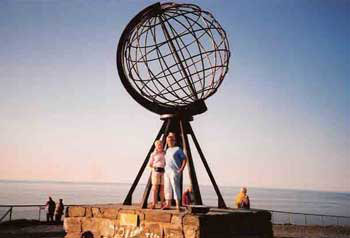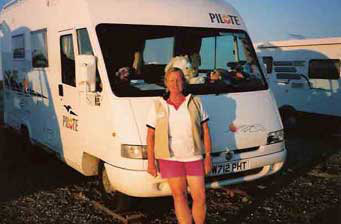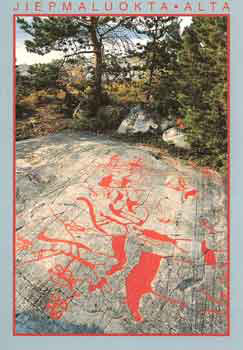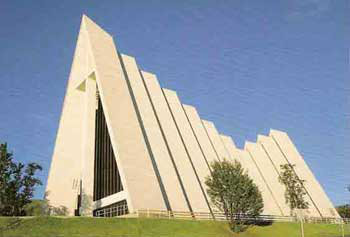
The Website for St George’s Church, Waterlooville and its Parish Magazine St George’s News

After passing through Finland it was right hand down a bit and head north to the land of the midnight sun, the last 400 miles to Nordkapp up through Finnmark, Norway’s most northerly county and the largest, covering an area of 18,000 sq miles but with a population of only 75,000 a mixture of Norwegian, Sunni (Lapps) and Finns. The scenery much different now, very rocky not many trees and even though it was lovely and sunny with wall to wall blue sky there was still plenty of snow around but very patchy. The reindeer seemed to congregate on these patches of snow I suppose it was to keep cool, although being so far north I was still wearing shorts and polo shirt even at this latitude.
The island of Mageroya on which Nordkapp stands is reached by ferry or tunnel from Kafjord coming out at Honningsvag, this is a very long tunnel which was not as well lit or as wide as the tunnels in most places I have visited. Approaching this tunnel I put on my headlights took off my sun glasses and upon entering “I could not see a thing”, thinking my lights were not working it was almost panic stations, I must have gone over a kilometre before my eyes started adjusting, even then it was not easy to see. I was so lucky not to have met a large vehicle coming the other way when I first entered. On leaving the tunnel it was only another 20 miles to Nordkapp itself, the total journey from Klippan in Sweden was 1555 miles and took us four days, not bad considering the roads. North Cape itself is a barren headland with visitor centre and monuments, one being a large hollow globe on a huge plinth, I gather this monument is like the Holy Grail to cyclists as they were getting up on it with their bikes of all shapes and sizes, to have their photo taken to prove they had reached their goal.
The name North Cape was given to this imposing headland by an Englishman, Captain Richard Chancellor when rounding this most dramatic northern point while trying to find a route to China. Although treeless there is an unusual beauty about this island on a sunny day emphasized by the clarity of the atmosphere.
The first organized tour to here was by Thomas Cook in 1875, this was by sea as the first road to this point was not built until 1956 as was the first visitor centre. The new North Cape Hall has the usual souvenir shop and cafeteria etc, it also has an under ground tunnel cut through the rock to a balcony on the front of the cliff which gives a spectacular view to the Arctic Ocean 1000ft below and far away into the distance. Outside the visitor centre are seven large circular wheel like sculptures, they are monuments to the children of the world, sculptured in 1988 designed by seven children from seven lands as monuments to “Joy, friendship, and working together”.
Our reason for getting to this point was to see the midnight sun, as at this time of the year the sun never sets, it comes down to sea level then rises up again. My friends and I sat outside at midnight celebrating with a bottle or two, still wearing shorts and sleeveless tops as it was so warm. After two nights or should I say days it was time to move on leaving the island and start heading south down through Norway, a journey of almost 2000 miles.
The first stop being Alta which is not far from the Russian border, it was devastated by the Germans scorched earth policy when they were retreating from the Russian advance in 1944. One of the main attractions there are the rock paintings and carving from the prehistoric period of about 10,000 years ago, they were not discovered until 1975 and are in excellent condition. There are four such sites in the area, we visited just one, had I been travelling on my own I would have stayed longer and visited all four as they were so interesting.
The large glacier worn and sea washed boulders which the paintings were on are hundreds of feet above sea level, although when painted they were just above the shore line, since then the land has been rising due to the loss of the tremendous weight upon it caused by the glaciers, which were in places miles thick.
Moving on south to Tromso, sometimes called Gateway to the Arctic, the most striking thing I remember as I approached the town was the impressive building, The Cathedral of the North completed in 1965, being white it really stood out. It was just as spectacular on the inside part of it due to the huge 75ft stained-glass window by Victor Sparre.
The town also contains Europe’s northernmost brewery, Mack, famous for its Arctic Ale. “Thought the men might like to know that!” It was not far from here, where the German battle ship Tirpitz was sunk in the Second World War, while guarding the entrance to Tromso.
Moving on again 150mls south is Narvic which is an ice free port, most of the iron mined in northern Sweden is shipped from here. It was also the scene of some very bitter fighting during WW2. We only spent a few hours here before moving on further south.
This will have to be covered in my next article if I have not bored you all silly by then with my ramblings or if I can stay at home long enough to write it up.
Christine Culley
From St George’s News Archives,
first published Easter 2008

With friend at North Cape












